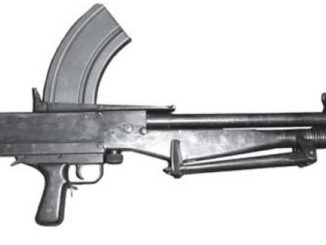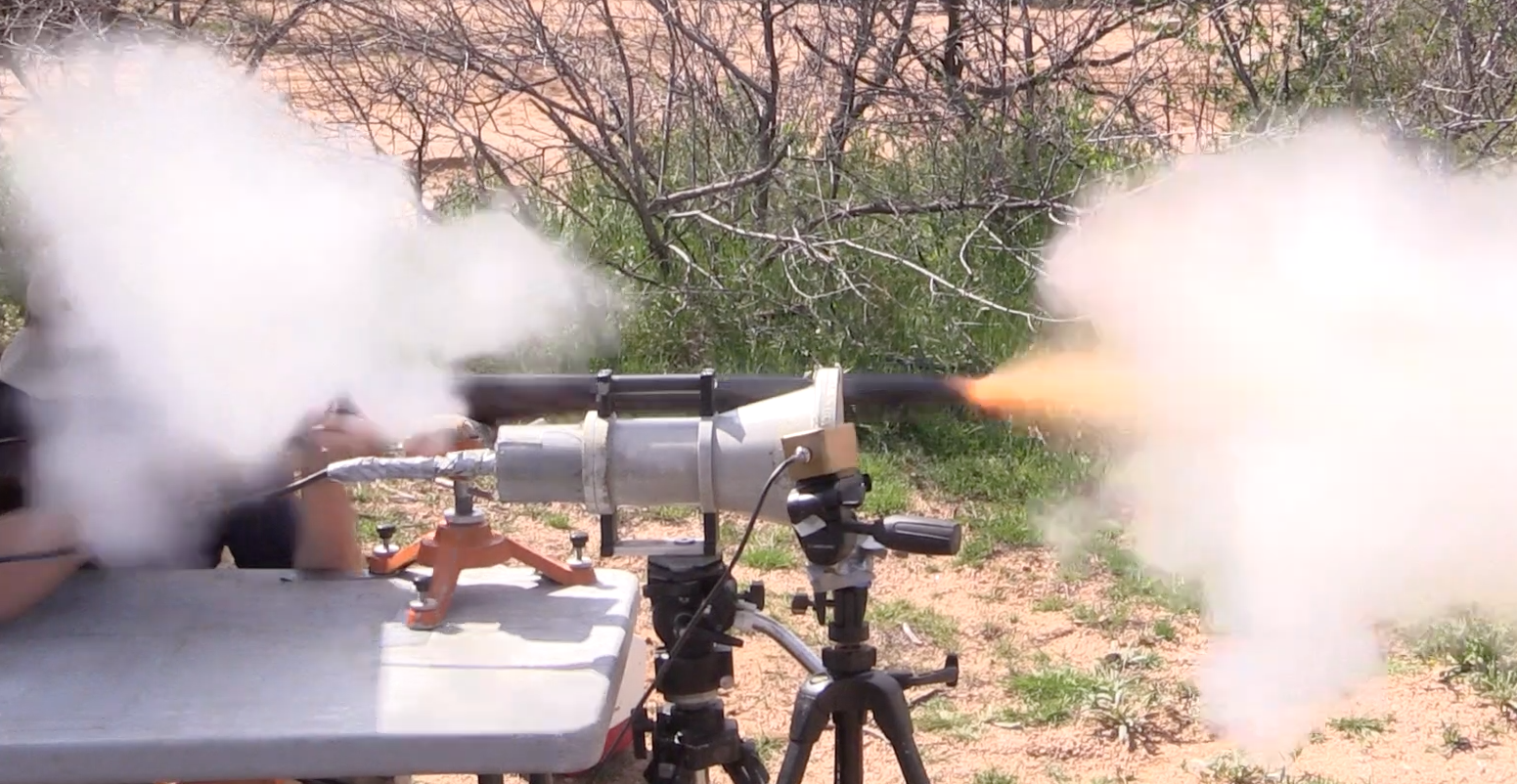This is lot #1347 in the upcoming RIA Premier Auction. It was scheduled for April, but has been postponed – check their web site for upcoming Online Only auctions every month, though!
William Tranter’s Model 1868 revolver was his first centerfire design, and became very popular, made in a wide variety of sizes and styles. One of the very rarest of these today is the 5-shot .577 Boxer caliber, an absolute monstrosity of a revolver made for British adventurers worried about facing down lions and tigers. This is the only known engraved example, and it is beautifully done.




“Say hello to my little friend, Mr Leon!” Bang! So much for the man-eating lion story… just kidding!
400 grains @ 725 F/S equals 466 FPE. So we’re talking about a round with the muzzle energy of the modern U.S. military standard 9 x 19mm, which trends into the lower end of the .357 Magnum range.
Keep in mind that romantic views of the Raj notwithstanding, the primary target of a revolver like this would be an obstreperous native, not a tiger or other four-footed local. Five rounds rapid was considered to be enough for an officer to defend himself in a scrum if the natives somehow got past the rifle line to try to put an assegai up his jacksey, and by that time he should already be using his sword with the other hand and the RSM should be covering his back.
As an historical note, a revolver like this, or the aforementioned Webley-Pryse top-break .577, is what Lts. Bromhead and Chard would have most likely been wielding at Rorke’s Drift on 23 Jan 1879, never mind what the 1964 movie Zulu showed.
cheers
eon
1) There is a painting of the era that shows an officer wielding a Colt. As neither Lieutenant was a wealthy aristocrat I would assume they would have purchased more pedestrian arms suitable to Army issue ammunition. The famous painting of the battle shows a casualty dropping an Adams-type revolver of ordinary proportion.
2) Tranter was a real pioneer in double action (as opposed to self-cocking aka double action only) and showed Adams a thing or two. His folding double trigger, seen on revolvers and Lancaster howdah pistols, has not gotten enough attention on this channel.
It harkens back to an age when more respect was paid to bullet diameter and weight than velocity. Sadly, a prejudice that still persists in some minds to this day. Just imagine the muzzle energy if they had halved the bullet weight and doubled the velocity.
They really couldn’t do that with black powder. The reason long-range rifles of the era had barrels considerably longer than is typical today (up to 40″/1m) is that to get a bullet in a rifled bore up over the speed of sound, you needed a heavy charge of black powder and a long barrel for it to fully combust in.
While black powder is emphatically not “progressive burning”, it takes time for the gas pressure to build up and accelerate the bullet, and that means a long barrel if you want high velocities (over 1,000 feet per second).
Short-barreled weapons like handguns had an upper velocity limit of about 900 F/S, and very few black-powder cartridge arms had enough powder capacity to achieve even that. Most had MVs in the 650 to 750 F/S range, at best.
With that limitation in mind, especially with a revolver with a short barrel for fast handling in a close fight (and too short for the other guy to grab it and use it on you), the only way to achieve higher kinetic energy values was to go to heavier bullets. And those bullets couldn’t have much over a 2:1 length to beam ratio for usable accuracy.
Which meant that the upper limit for mass in a .45in bullet would be about 250 to 300 grains. The U.S. Army standard .45 Colt round fired a 255 grain bullet at 850 F/S from the 7.5 in barrel of the Colt Model 1873, for 410 FPE.
If your gun’s barrel was shorter, and your powder charge smaller, you were stuck with 700 F/S range MVs. To get more killing power, you needed a considerably heavier bullet. And once bullet weight requirement exceeded 300 grains, .45in was no longer a big enough bore size to accommodate it. Hence the .50 and .577 revolvers and their ammunition.
19th Century gun and ammunition designers did the best they could with the propellants they had. And breathed a massive sigh of relief when smokeless powder came along in the 1880s, and solved most of the problems that had bedeviled them and their predecessors since the 14th Century.
cheers
eon
Because of the lower gas production of black powder (only about 1/3 of nitrocellulose), the only way to efficiently get momentum and energy was to increase the bore diameter.
That was especially true when short barrels were used.
Muzzle energy does look and sound impressive, as it is the square of velocity (1/2M x v^2)
With well made expanding bullets, there is the chance of efficient energy transfer, even when there are no secondary particles from broken bones.
In theory, and big slow moving bullet should be good at transferring it’s energy and causing damage without relying on expansion
But even then, as the smokeless powder age, slaughter yard trials that (without any sound argument that was based on the results) recommended .45″ as the minimum for an American service pistol showed,unexpected things can happen…
Such as the only 1 shot instant knockdown and kill with a chest shot on cattle, during that trial, was FMJ 7.65mm parabellum.
Chard’s revolver is in the collection of the Royal Engineers Museum. It’s a Webley RIC.
I’m not sure what Bromhead carried, but it was in the same caliber as Smith-Dorrien’s revolver, as the latter acquired 11 rounds of ammunition from the former the morning of 22 January.
I can imagine that most of the time this brute failed to stop a threat is because the shooter missed!
If you can’t aim a gunshot, a blade strike, or even a bludgeon whack very well, you may as well go and fight with your bare hands while praying not to die!
I watched this video and wondered if the gun in SA/DA? I tried to watch it again but it won’t play. I noticed a heavy over travel block on the trigger. Anybody know?
“I watched this video and wondered if the gun in SA/DA?”
As far as I know: yes, it has a DA/SA trigger system. Very likely the trigger mechanism is identical with the Tranter 1858 Model 4: [https://www.youtube.com/watch?v=F6m3m3Ym9vQ].
In one closeup, you can see that the hammer is back at full-cock. So yes, it is in fact a double-action, although under most circumstances the drill manual called for trigger-cocking in close combat.
cheers
eon
Thanks Eon,
I did notice one section that showed it cocked. I was wondering if it was DA also. I really enjoy Forgotten Weapons. My wife always knows when I have my ear phones on what I am watching. Thanks again.
By the way: what is the connection between .577 Boxer and 600 Gilon?
According to a comment, it is “non-heeled version of .577 [Boxer?]”.[https://www.forgottenweapons.com/1847-walker-revolver-at-ria/] But how can a cartridge variant with non-heeled bullet have a larger diameter than a variant with heeled bullet?
It is a pretty misterious cartridge: I am not even sure, its proper spelling is Gilon or Gillon.
Technically, the .577 Boxer got its designation from its parent cartridge case, the .577 Snider/Enfield rifle cartridge. That case is actually slightly tapered, and when you cut it down to revolver length, you end up with a case mouth diameter large enough for a true .600in bullet.
Strictly speaking, the .577 Boxer should be called the .577/.600, as with the .577/.450 Martini-Henry rifle cartridge. The first number designating the parent case, the second indicating the actual bullet diameter and bore spec.
Yes, “.577 Boxer”-chambered revolvers and other handguns are actually .600 caliber. A difference of .013″, about the thickness of a playing card, that can really only be detected with a micrometer.
And yes, this is why a .577 Snider-Enfield bullet mould cannot generally be used to mould bullets for the revolvers, even with a plug to reduce their length and thus bullet weight to the 400-grain range suitable for the pistol. Unless the bullet base upsets on firing like a Minie’ ball, the bullet is likely to “skate” down the tops of the lands without taking up much spin, which results in very poor accuracy.
cheers
eon
Thank you for your detailed answer. 🙂
The gun is in SA/DA. The projection behind the trigger goes through the back of the trigger guard to trip the internal SA sear.
GHJ
The revolver is in SA/DA. The projection behind the trigger goes through the back of the trigger guard to trip the internal SA sear.
GHJ
A Friend’s father had possibly the best collection of Adams and Tranter revolvers.
Unfortunately some were confiscated and destroyed in the 1997 handgun ban!
The remainder passed to my friend afterms his Father died.
Due to work commitments, I didn’t get to see them.
Eventually his sister wanted a share of the financial proceeds, and so the collection was auctioned.
I don’t know whether this gun had ever passed through that collection.
Bromhead and Chard at Rorke’s Drift would, unless carrying personally pursached pistols, have been using standard issue .442” Beaumont-Adams revolvers. Not the 1916-era Webley MkVIs shown in “Zulu”.
If you watch “Zulu” closely (brilliant movie, by the way), a few of the soldiers are actually using long Lee-Enfield, not Martini-Henry’s.
The caliber is good, but the energy is too low.
For firing at tigers and lions, the cartridge is definitely weak.
Although used even in Howdah, it is more likely to be “human” cartridge.
And its prevalence is due solely to accessibility. In those days, there were no sporting goods stores on every corner, and this cartridge was made on the basis of the cartridge of the 577 Snider–Enfield rifle and it can easily be made from its cartridges.
“Unless the bullet base upsets on firing like a Minie ’ball…”(С)
All the bullets of the time were Minie. They have too much weight for a pistol. But this is easily solved by shortening the bullet. And for a stone throw distance, special accuracy is not needed.
In addition, shot cartridges were common. Perhaps the purpose of such a gun, namely snake shooting?..
Based on many gun mag articles and posts, the Colt Walker with the nine-inch barrel could achieve 1100-1200 feet per second with a 140-150 grain bullet or ball. Thus, you do not need a larger than .50 caliber to get good knockdown power with good quality black powder. According to CARTRIDGES OF THE WORLD, 40 grains of Black Powder in a Colt Calvary Model would result in about 930 FPS with a 255 grain .45 bullet. Again, good stopping power. I wonder if anyone has tested a so-called Buntline Special with the extra long barrel?
Because there was no 50 cal revolver yet
Howdah Pistol in the equivalent of a Twenty Gauge Shot Gun round was a Go-To Gun for Tiger Hunting. Two shots was enough for a backup. I used it in a fiction book I wrote.